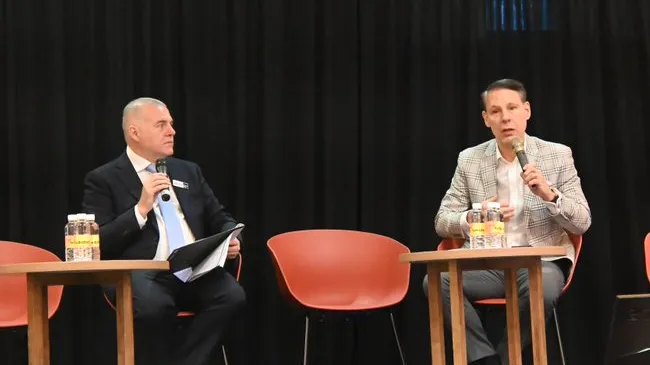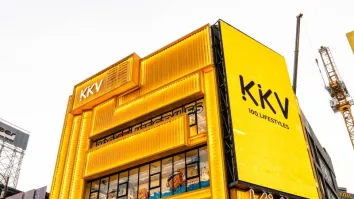
Why DFI Retail Group leads the charge in Asian retail sustainability
CEO Scott Price shares how the goal to become sustainable extends to fostering a secure environment for consumers, shareholders, and workers.
Going beyond the norms of promoting environmental policies and green practices, DFI Retail Group is establishing itself as a pioneer in holistic retail sustainability in Asia.
As if its commitment to a 50% reduction in carbon footprint by 2030 and achieving net zero by 2050 were not bold enough, DFI Retail Group CEO Scott Price aims for sustainability plans that encompass not just store operations but ethical sourcing and transitioning to more sustainable packaging.
In this engaging Fireside Chat with Retail Asia Editor-in-Chief Tim Charlton, Price acknowledges the challenge of aligning green initiatives with consumer and shareholder expectations whilst sharing the steps the Hong Kong-based retail firm has taken in attaining the most ideal of sustainability goals.
Sustainability is becoming a big issue. How has DFI Retail Group embraced eco-friendly practices in operations? And what tangible steps did it take to reduce environmental footprints?
Ten years ago, ESG ended up looking like a headline that companies talked about. But nowadays, it has turned into data-driven and commitment-driven initiatives that drive both reputational and economic impact for the value of the company. In DFI, we have moved to a more definitive set of commitments and delivered upon them.
We have committed on Scopes 1, 2, and 3 to a 50% reduction by 2030 – a net zero by 2050. Now the reality is [that] Scope 3 is a much bigger part of what everyone has to grapple with. For retailers, Scope 3 is the supply chain. It is the footprint of everything that we sell. In terms of our commitment, we reduce our carbon footprint by 30% by the year 2030. How [do] we then go further? Because there is a huge amount of complexity in measuring it.
In terms of Scopes 1 and 2… the focus is on reduced footprint in our stores, from refrigerators to LED lighting, like the use of coolants or water cooling. All have a dramatically lower carbon footprint, where possible gases have a lower impact.
In terms of Scope 3, the scope revolves around negotiating with our suppliers. For fresh foods, if the global suppliers have supply coming from committed companies that have made the same commitment as us, we have a better chance.
We are accountable for our brand, taking responsibility for the freshness, the quality and the sourcing of the food, no matter [what] the challenge poses. So far, we have been SBTi-validated, becoming the second retailer in Asia that has this science-based target initiative approval on our plan. DFI is on the right path.
Like water-cooling that uses less electricity, what other tangible measures can be implemented to enhance sustainability in store operations?
Solar is one of the most challenging sources to implement in very dense urban environments, especially in our Asian operations. When a business does its operations inside a mall, it has to join with other tenants, not having any control of the infrastructure. As for us, we take every effort in partnerships.
Previously, we collaborated with Jardines Group and Hong Kong Land. Recently, we had our sustainability leadership council meeting, gathering all heads of all involved businesses and our main shareholders. Hong Kong Land is a great example of a landlord, in essence, ensuring that they are delivering [green commitments] to their tenants.
For us, we serve like tenants, ensuring that they are pulling electricity from more sustainable grids, like solar and wind. We also heavily regard buildings if they are sustainably constructed, or have an enormously negative carbon footprint. We chose a more carbon-friendly type of building material that has the same longevity as concrete.
In terms of ethical sourcing, how was DFI Retail able to apply it? Any significant difficulties and victories that came with it?
The G of ESG is around governance. Thus, to govern those commitments is to have the infrastructure to be ethical. First off, we have committed to caring for animals, ensuring that the supply chain is designed to ethically manage animals and those proteins. We are increasing investment on not just our brand, but on vegetarian options that are created sustainably.
Next is around the governance of auditing of human rights. Through a significant auditing cycle, several labour practices have been more accountable. For example, when seafood in several Southeast Asian countries is managed unfairly, given the red flags on human rights, DFI implements a non-negotiable plan to audit it twice. Get a red, and it is off our list.
Things like holding access to someone’s passport are another non-negotiable topic. When employees sign up, employers need to ensure that we are fair through the process. Employers should not withhold access to very negotiable documents like passports from their employees.
How did you find out that those suppliers were locking passports? Were your auditors able to investigate the matter?
We talk to the employees. During our audits [surprise audits usually], we discussed it with frontline employees. It depends on the seasonality, especially with the vegetable inventory. But for those in fisheries, we do surprise audits. We asked workers questions, like “Do you have access to your passport?” Then, fast forward to audit #2, the boss now wants them to hold on to their passport because they might be stolen. From there, it is clear we need a different solution.
With such an in-depth supply chain, it can be challenging to audit them. On committing to ethical sourcing, how do you ensure that the quality of your products extends with the supply?
DFI Retail has a quality assurance team. On our audits, it is surprising to see many Asian suppliers pass on the first audit. Coming from Walmart, the responsibility for sourcing was part of the job. And the sourcing results were not great. The failure rate is very high. So, there is a high expectation for developing economies that would have less time to invest in this infrastructure to gain progress.
And that remains the biggest surprise is how seriously the reaction of those developing economies to protect that part of their economy by saying, “If we’re going to have these large-scale retailers coming in confidently source from us, all will be non-negotiable on this topic.” It is all a positive outcome.
With products offered and packaged in plastic, what are the challenges in dealing with its frequent use? What are the significant wins and difficult areas to adapt a more sustainable packaging?
There are two fronts here. First is our brand moving out of high-density HDPE into recyclable path PET plastics and into the circular economy. We aim for plastics to be a mainstay, considering customer behaviour. It takes customers to be willing to participate with a solid infrastructure.
The second is getting biodegradable with plastics that can serve as wrapping for vegetables. Studies came to analysing the best substitutes for plastics. One is designing a plastic that lasts two to three weeks. Once we get to its full degradation, we can divert them out of landfills. By 2025, we may reduce half of landfill movements, and then by 80% by 2030. While 20% can be challenging, DFI is working on solutions to get to 100%.
How have you effectively communicated DFI’s sustainability initiatives to its customers?
It boils down to two viewpoints. The first is from the customer. The second is from the shareholder. Speaking for the latter, there is the practice dubbed the “tyranny of the alphabet,” where various NGOs and organisations are creating rules to measure from a shareholder viewpoint. The aim is to stay fact-based. Without a fact-based approach, the “alphabet” hits back. The advantage for us is an organisation called Sustainalytics, which studied the top 120 retailers around the world on their sustainability. DFI was in the top half last year at 59. Currently, we are at 35. From here, progress is inevitable to provide a fact-based fostering environment for consumers.
But maintaining sustainability is a challenge for retailers. There is an enormous reputational danger in getting caught in greenwashing and making claims that soon become non-deliverable. Customers have a preconceived expectation, especially with net-zero carbon commitments.
The important factor, going back to Scope 3, is finding the right means to communicate our sustainability commitment. This means differentiating which products are delivering on our sustainability commitment, and which ones are not. But the priority is capturing customer perception and expectation, instead of technical compliance, to make sustainability count.
How do you balance the cost and investment versus the benefits of sustainability initiatives?
What can happen is for the International Financial Reporting Standards (IFRS), the international body that governs the accounting rules of the world, to start requiring companies to publish their annual reports. Technically, this affects the employed cost of DFI to achieve the 2050 carbon commitment. I believe within five to eight years, they will require companies to depreciate or amortise it.
But that leaves DFI to lay out smart strategies for how to invest in that technology at a reduced cost without affecting the stock price. However, for retail, it is more feasible than other industries, like aviation wherein every major airline needs to commit to zero carbon, despite the lack of affordable aviation fuel. Saps can be used. However, they make a greater carbon footprint than fossil fuels. Their balance sheets will be challenged.
Before passing that innovation, the appropriate approach is to be efficient with a fully sustainable basket that has a carbon zero footprint for consumers and to maintain a margin and a few future total shareholder return (TSR) for investors.
Looking at other retailers, what general advice could you give those on a sustainability journey, especially regarding their scope? What are some of the easiest wins that they can get?
It takes simplicity, like not running coolers that are half-empty, or keeping the usage of electricity at a store level. It costs nothing. It is behavioural. There’s no CapEx involved. There are no optics involved. It’s simply the behaviour.
With a low CapEx, the next step is understanding where the grid is coming from, and what its carbon footprint is. In some markets, this may not be feasible, wherein [there is] a single provider or the government is the provider. The other step is offsetting somewhere else, which may have a cost. And the carbon pricing markets are slightly in flux. Much like the early days of cryptocurrency, this will come down.
Third, it is staying cognisant of the type of infrastructure you are investing in. When you set up a store, you will have a long-term view, like 20 years from now. By that time, the results of the 2050 commitment are right before your eyes. Right now, retailers need to be able to light and operate in a carbon-zero manner. Start your CapEx today that is 100% compliant. Otherwise, your balance sheet in the future will be carrying that debt. Become net zero and operate as net zero.
Any final thoughts you would like to talk about?
Retail is the most complicated simple business in the world. People go, “How hard is it? Are you by yourself? You know, that’s easy.” But it is not. The challenge is choosing “fresh.” Customers sought “fresh.” If not, it is getting rid of – the economics of wastage. In a world of sustainability, we are motivated to have zero waste. And that’s the complexity.
With technology like Gen AI to be able to solve these problems, to be able to use the data available, robust and detailed — how do you leverage that data to say on the third Tuesday of September with or without a holiday? What is the right amount of apples to be ordered to have in the store? That should help us in the area of “fresh” to continue to drive sophistication.
Take that across the whole array of 10 to 15 to 20,000 stock-keeping units (SKUs) that sit in your store. Therein lies the complexity of retail shake.



















 Advertise
Advertise





